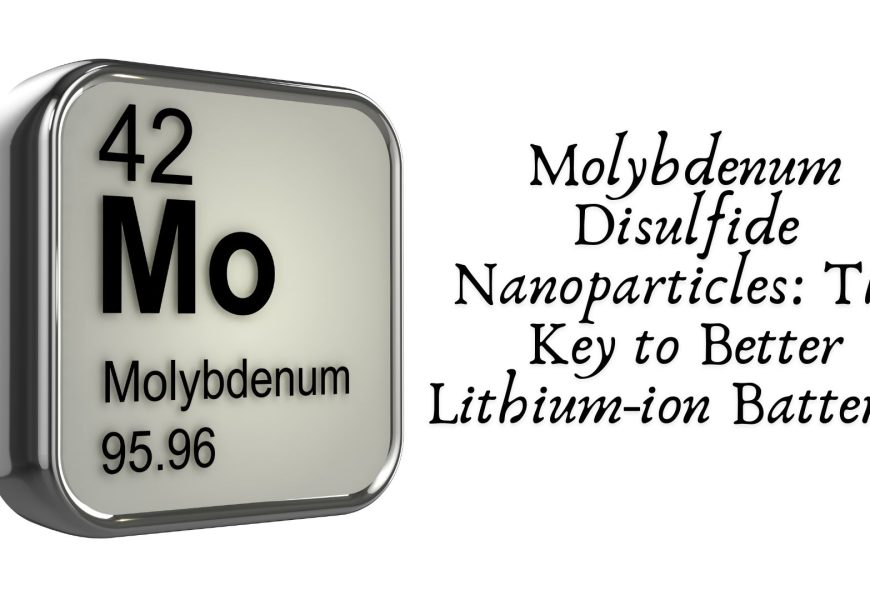Lithium-ion batteries (LIBs) have transformed modern electronics, providing efficient energy storage solutions for devices ranging from smartphones to electric vehicles. Despite their success, researchers are constantly seeking to enhance battery performance, including improving energy density, longevity, and charging times. One promising development in this area is the use of molybdenum disulfide nanoparticles (MoS₂), a material known for its unique properties that could revolutionize the future of lithium-ion batteries.
What are Molybdenum Disulfide Nanoparticles?
Molybdenum disulfide (MoS₂) is a layered material that exhibits remarkable mechanical, electrical, and thermal properties. It is part of the transition metal dichalcogenides (TMDs) family, which has gained attention in nanotechnology and materials science due to its versatility. In its bulk form, MoS₂ is commonly used as a solid lubricant, but when reduced to the nanoscale, its properties change dramatically.
MoS₂ nanoparticles consist of layers of molybdenum atoms sandwiched between sulfur atoms, which allows it to be extremely thin—down to a single layer. These layers can slide over each other easily, giving the material flexibility and unique electronic characteristics. The reduced dimensionality enhances its potential as a material for energy storage applications, including LIBs.
Challenges with Current Lithium-ion Batteries
The rapid growth in the demand for LIBs has exposed some of the limitations of the current technology. For instance, while graphite is widely used as the anode material in LIBs, it has reached a performance plateau. Graphite anodes have limited capacity (372 mAh/g) and struggle to accommodate the growing energy storage needs in electric vehicles and large-scale energy grids.
Other challenges include:
- Limited Cycle Life: As LIBs undergo repeated charging and discharging cycles, the materials inside degrade over time, reducing the battery’s lifespan.
- Slow Charging Rates: Charging LIBs quickly can cause overheating and pose safety risks due to the growth of lithium dendrites.
- Energy Density: There is a growing need for batteries with higher energy densities to provide more power while keeping the battery size manageable.
How MoS₂ Nanoparticles Address Lithium-ion Battery Limitations
MoS₂ nanoparticles present a promising solution to many of these challenges due to their unique properties. Here are several ways in which MoS₂ nanoparticles can enhance lithium-ion battery performance:
High Surface Area and Enhanced Energy Density
The nanostructure of MoS₂ offers a high surface area, which allows for greater interaction between lithium ions and the electrode. This characteristic leads to an increase in the battery’s energy density, meaning more energy can be stored per unit mass. By replacing traditional anode materials like graphite with MoS₂, researchers have achieved higher theoretical capacities of up to 670 mAh/g, nearly twice that of graphite.
Improved Cycling Stability
One of the main challenges for LIBs is the degradation of electrode materials during the charge-discharge cycles, which limits the battery’s life span. MoS₂ nanoparticles are highly flexible, which helps them to better accommodate the expansion and contraction that occurs during lithium intercalation and de-intercalation. This flexibility reduces the risk of cracking or pulverization of the anode material, resulting in improved cycling stability and a longer battery lifespan.
Faster Charging Speeds
MoS₂ nanoparticles offer excellent electrical conductivity, which is critical for improving the charging rate of lithium-ion batteries. Due to the ultrathin nature of MoS₂, electrons can move through the material more efficiently, resulting in faster charge-discharge cycles without causing detrimental effects like overheating. Additionally, MoS₂ nanoparticles provide numerous pathways for lithium ions to travel, reducing the diffusion distance and speeding up the overall process. This capability can potentially reduce charging times significantly.
Prevention of Lithium Dendrite Formation
One of the most significant risks with rapid charging in LIBs is the formation of lithium dendrites, which are needle-like structures that can grow on the battery’s electrodes, leading to short circuits and even battery failure. MoS₂ nanoparticles can help prevent this issue. Their layered structure and the ability to absorb strain during cycling make it difficult for lithium dendrites to form, enhancing the safety of lithium-ion batteries.
Recent Advances and Research in MoS₂-based Lithium-ion Batteries
The use of MoS₂ nanoparticles in LIBs has been the subject of intense research. Scientists are exploring various methods to optimize the performance of MoS₂ anodes, including the development of hybrid materials and nanocomposites. By combining MoS₂ with other materials, researchers can create synergistic effects that further enhance conductivity, stability, and capacity.
For example, graphene-MoS₂ nanocomposites have shown significant promise. The high conductivity of graphene complements the energy storage capabilities of MoS₂, leading to improved overall performance. Other approaches involve doping MoS₂ with elements such as nitrogen or carbon to enhance its electrical properties.
The Future of Molybdenum Disulfide in Energy Storage
The potential of MoS₂ nanoparticles in lithium-ion batteries is vast, but there are still some challenges to overcome. One key area of research is the scalability of MoS₂ nanoparticle production. While the material has demonstrated impressive properties in laboratory settings, researchers must find efficient ways to produce MoS₂ nanoparticles at a commercial scale to make them viable for widespread use.
Additionally, cost-effectiveness will play a critical role in determining the future of MoS₂-based LIBs. As researchers continue to explore new synthesis methods and refine the material’s performance, the economic feasibility of using MoS₂ in commercial batteries will become clearer.
Conclusion
Molybdenum disulfide nanoparticles represent a key innovation in the development of next-generation lithium-ion batteries. With their high capacity, excellent cycling stability, fast charging capabilities, and enhanced safety features, MoS₂ has the potential to address many of the limitations that currently plague LIBs. As research progresses and commercial viability improves, we may see MoS₂ nanoparticles become a cornerstone of the energy storage industry, paving the way for more powerful, longer-lasting, and safer lithium-ion batteries.
By integrating MoS₂ into the design of future batteries, industries such as electric vehicles, consumer electronics, and renewable energy storage could see significant advancements in performance, helping to meet the ever-growing demands for energy in a sustainable and efficient manner.











